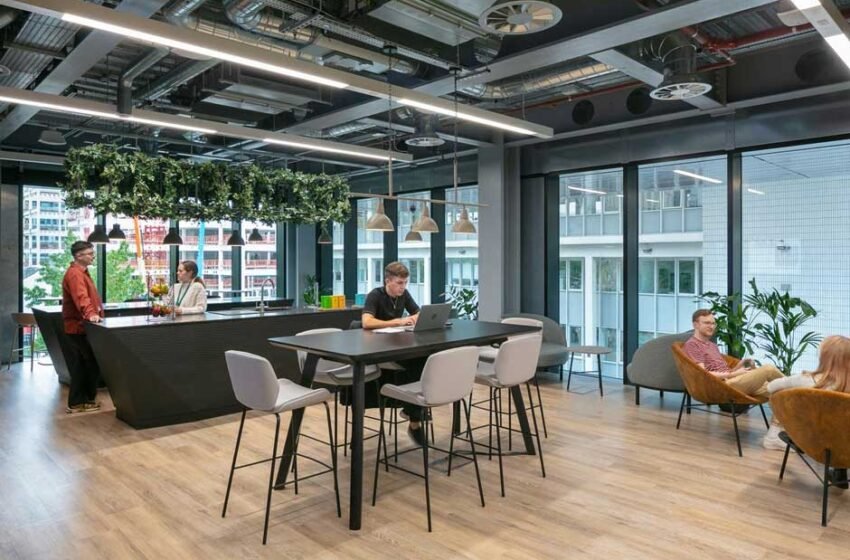Modern Commercial Design Trends That Attract and Convert Customers

Many business owners struggle to make their stores or offices stand out. New design trends can help attract more customers and boost sales. This blog will show you easy ways to upgrade your space for better results.
Keep reading to learn smart ideas that work.
Sustainable and Eco-Friendly Designs
Sustainable and eco-friendly designs focus on using green materials. These choices help protect the environment while attracting customers who care about sustainability.
Net Zero Energy Buildings
Net Zero Energy Buildings produce as much energy as they use during a year. These buildings often use solar panels, LED lighting, and smart sensors to lower power needs. The U.S. Green Building Council says the number of net-zero commercial projects keeps growing each year.
Many modern commercial design trends now focus on these efficient spaces. Net Zero Energy Buildings support sustainability goals and help companies stand out to eco-conscious customers.
Lower utility bills also improve profit margins while showing a strong brand commitment to clean practices. Large retailers like Walmart and Target now add more of these features in new stores, helping their brands lead with green innovation in commercial architecture and interior design.
Use of Recycled and Renewable Materials
Many commercial design projects now use recycled and renewable materials. Designers choose reclaimed wood, recycled steel, and glass from old buildings. Companies like Adidas are making retail spaces with ocean plastic floors. These choices cut waste and lower carbon footprints in interior design. Buildings can earn LEED certification with these eco-friendly materials.
Bamboo panels and cork flooring appear more often in modern stores and offices. Both grow quickly and need few resources to produce. Brands use these materials to show their commitment to sustainability; this helps build customer trust and loyalty. Retail trends point toward using technology alongside sustainable products.
Tech-Integrated Commercial Spaces
Tech-integrated commercial spaces change how we shop and work. Smart buildings use advanced technology to improve efficiency and user experience.
Smart and AI-Driven Buildings
Smart and AI-driven buildings use advanced systems to improve customer experience. Sensors control lighting, temperature, and security in real time. These features help save energy and lower costs for businesses.
The Edge building in Amsterdam uses 28,000 sensors to track how people move and adjust the environment to fit their needs.
AI tools learn from customer patterns inside retail spaces. They predict busy hours, customize music or displays, and even control digital signs based on who is present. This technology integration helps commercial spaces feel more personal and efficient while supporting brand aesthetics and user experience.
Incorporating Augmented Reality (AR) in Retail
Augmented Reality (AR) changes how customers shop. Retailers use AR to create fun and engaging experiences. Customers can try on clothes or see how furniture fits in their homes without leaving their couches.
This technology helps brands connect with shoppers in new ways. For example, IKEA allows users to place virtual furniture in their own spaces using a smartphone app. The easy-to-use features make shopping exciting.
These interactive designs boost customer engagement and improve the experience. Shoppers feel more confident making choices when they can visualize products clearly. AR also provides valuable data for brands, helping them better understand consumer behavior.
With these insights, retailers can adjust marketing strategies to meet customer needs more effectively. “Innovation is seeing what everybody has seen and thinking what nobody has thought.”.
Wellness-Centric Interior Design
Wellness-centric interior design focuses on creating healthy spaces. It uses natural elements to boost mood and improve well-being in both workplaces and retail environments.
Biophilic Design and Natural Elements
Biophilic design brings nature into commercial spaces. It uses natural elements like plants, sunlight, and water. This design improves customer experience and makes people feel good. Studies show that having greenery in a space can reduce stress and increase focus.
Natural light is also key in biophilic design. It creates warmth and a welcoming atmosphere. Spaces with large windows often attract more customers. These features appeal to shoppers and also help brands stand out.
Including these elements shows a commitment to sustainability while improving the aesthetic of the environment.
Spaces Promoting Employee Well-Being
Creating spaces that promote employee well-being is essential in modern commercial design. These areas focus on comfort and health. Natural light, plants, and quiet zones help employees feel relaxed and focused. Open layouts encourage collaboration while private nooks offer a place for quiet work.
Well-designed break rooms provide a space for relaxation and socializing. Ergonomic furniture supports physical health during long work hours. Incorporating wellness activities, like yoga or meditation rooms, boosts morale and productivity.
Various real-world examples, like Parkplace by Highlands, show how thoughtful design can support both comfort and community, blending wellness principles with inviting, modern aesthetics for senior living environments.
Bold and Personalized Aesthetics
Bold and personalized aesthetics draw customers in. Bright colors and unique designs make spaces memorable. They help brands stand out from the crowd. Personal touches create a connection with customers that keeps them coming back.
Vibrant Colors and Statement Pieces
Vibrant colors attract attention. They create energy in commercial spaces. Bright reds, blues, and yellows can make a brand memorable. These colors influence customer feelings and choices. A bold color palette enhances user experience. It draws customers in and keeps them interested.
Statement pieces add uniqueness to a space. Large artwork or standout furniture can serve as focal points. These elements reflect a brand’s identity clearly. Retail environments that use these designs encourage exploration and engagement.
Customers are more likely to feel welcomed and inspired by their surroundings when vibrant colors and statement pieces highlight the space effectively.
Tailored Designs for Brand Identity
Bold colors and statement pieces attract attention. They set the tone for a brand’s identity. Custom designs reflect a company’s values and mission. Every detail matters, from logos to furniture choice.
Unique spaces create strong connections with customers. These designs enhance user experience while showcasing brand aesthetics. Businesses can stand out by blending style with purpose. Personal touches communicate the essence of their brand effectively, making it easier for customers to relate and engage.
Conclusion
Modern commercial design trends shape customer experiences. Eco-friendly designs attract buyers who care about the planet. Tech features enhance convenience and engage shoppers like never before.
Spaces focused on wellness improve moods and productivity for employees. Businesses that embrace bold aesthetics connect better with their audience, driving loyalty and sales.





